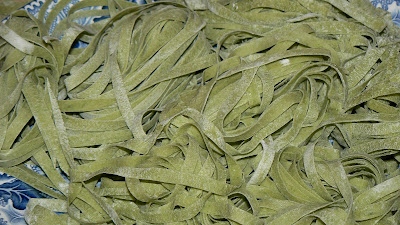YES! I've changed the background on the blog. I got tired of looking at eggs and thought a little distressed artwork would be a pleasant change. Besides, I saw the tiny Corot on the wall and knew I had to use it. One of my all time favorite painters! And the chair looks so well worn and comfortable . . . I could live in that space very easily. It reminded me of Rome, allora, ci doveva essere . . .
Risotto is a dish I have always cherished. I've written about it before - last September, all'Onda with large scampi. Be that as it may, it should be no surprise to anyone that risotto has many faces and since I was craving it with cherry tomatoes, I made some last night, but with the addition of a little ham and peas to finish it off. It really hit the spot. And, of course, the leftovers can be used for Arancini, which is precisely why I'm writing this blog entry. More to the point, someone sent me a link to another blog with a recipe for Arancini using sushi rice because of its sticky composition. This may be true, but Arborio or Carnoroli rice are no less dense once cooked and are perfect for making Risotto and Arancini. Sushi rice does not an authentic Italian rice ball make; if that were true, we'd be making our Toro and Unagi with Arborio rice - talk about going too far with this crossover and fusion business - the same, I AM AFRAID, should be said about panko versus real breadcrumbs. I can't help it that I'm a purist; it isn't Italian, I don't care what anyone says. LIke, "oh gosh, let's use panko flakes and mix them with the cheese, the ground fennel seeds, orange peel, and the oregano!" Egads! What's next? Soy sauce on your Panna Cotta?* You see my meaning, n'est çe pas? So that said, let us venture forth, treading lightly and never forgetting that we are Italians, if only for today. We shall use real ingredients, the fresher the better. And if it all came to you from a farm not 50 miles away from your door? All the better for you! Don't forget: risotto should be cooked over a very low heat, so be patient. The rewards are great for those willing to do the work to attain optimum results.
 |
| Click on photo for larger image |
3 tbs. Extra Virgin Olive Oil
3 tbs. butter (reserving 1/2 of it for the end)
1 small onion, minced
1 clove garlic, smashed and chopped to a paste
1/2 cup dry white wine
3 cups Risotto (I prefer Carnaroli)
4 cups simmering beef or chicken (or both; or veal if you really want to splurge) stock
1 flat cherry tomatoes (about 24), cut in half
3 slices prosciutto cotto or baked ham
Nutmeg
1/2 cup petite peas
1/4 cup heavy cream
1 cup Reggiano Parmigiano, grated
Heat a large, deep heavy-bottomed cast iron skillet (Le Creuset Dutch ovens are perfect for this). Add olive oil and half of the butter. Melt until sizzling and the bubbles begin to recede. Add onions, turn down the heat to low and saute until glistening and transparent (no more than a minute). Add the risotto and stir until all of the kernels are coated with oil. Add the white wine and cook until it has completely evaporated. Start adding a ladle full of stock at a time and stir constantly until almost all of the liquid has evaporated. Continue to add the stock in this fashion until it is completely used up. After the second or third ladleful, add the tomatoes so they cook in the liquid with the rice. Grate a little nutmeg into the risotto. Continue to cook and stir. After about 10 minutes, add the ham. Continue pouring and stirring until the rice is completely cooked but still retains a little crunch. After the last ladleful of stock has been used, test the risotto for doneness. If it is still too al dente, continue cooking with hot water (never put cold liquid into a hot cooking substance - it will arrest the cooking process), as always, one ladleful at a time. The entire cooking time should be about 35-40 minutes. After you've finished adding liquid, add the peas and the cream. Continue to stir until all ingredients are incorporated. The risotto should be very creamy. Add the remaining butter with 1/2 the cheese. Stir until the butter has melted. Salt and pepper to taste, grate another 2 or 3 dashes of nutmeg and serve immediately.
Serves 8 (with leftovers to be used in Arancini if so desired)
* All of these nightmarish imaginings are not real per se, but they, and much worse have been seen on various food shows which cater to the lowest common denominator, i.e., the mob. We've seen Sandra Lee use Campbell's Tomato Soup for her lasagna and get away it: it's called murder - or suicide - by sodium. I was recently forced to witness a toilet paper unrolling contest on Rachel Ray (in the doctor's office waiting room). What does two fat women unrolling toilet paper on TV have to do with food? Absolutely nothing. I only wish these ersatz cooks' ratings would plunge so they could disappear into the vulgar obscurity they so richly deserve. They are the ruination of fine cuisine. Julia is spewing ashes in her cremated grave.












